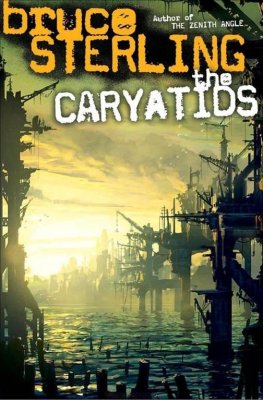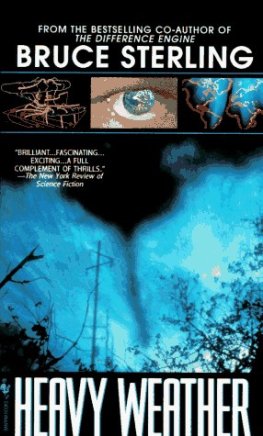Bruce Sterling - War Is Virtual Hell
Here you can read online Bruce Sterling - War Is Virtual Hell full text of the book (entire story) in english for free. Download pdf and epub, get meaning, cover and reviews about this ebook. genre: Science fiction. Description of the work, (preface) as well as reviews are available. Best literature library LitArk.com created for fans of good reading and offers a wide selection of genres:
Romance novel
Science fiction
Adventure
Detective
Science
History
Home and family
Prose
Art
Politics
Computer
Non-fiction
Religion
Business
Children
Humor
Choose a favorite category and find really read worthwhile books. Enjoy immersion in the world of imagination, feel the emotions of the characters or learn something new for yourself, make an fascinating discovery.

- Book:War Is Virtual Hell
- Author:
- Genre:
- Rating:4 / 5
- Favourites:Add to favourites
- Your mark:
- 80
- 1
- 2
- 3
- 4
- 5
War Is Virtual Hell: summary, description and annotation
We offer to read an annotation, description, summary or preface (depends on what the author of the book "War Is Virtual Hell" wrote himself). If you haven't found the necessary information about the book — write in the comments, we will try to find it.
War Is Virtual Hell — read online for free the complete book (whole text) full work
Below is the text of the book, divided by pages. System saving the place of the last page read, allows you to conveniently read the book "War Is Virtual Hell" online for free, without having to search again every time where you left off. Put a bookmark, and you can go to the page where you finished reading at any time.
Font size:
Interval:
Bookmark:
Bruce Sterling
War Is Virtual Hell
The First Company of the 12th Armored Cavalry Regiment prepared for virtual battle.
At the Combined Arms and Tactical Training Center (CATTC) in Fort Knox, Ky., the troops prepared to enter SIMNET - a virtual war delivered via network links. With the almost Disney-like mimicry typical of SIMNET operations, the warriors were briefed in an actual field command-post, with folding camp-stools, fly swatters, and stenciled jerry cans. The young tankers wore green- and-brown forest camouflage fatigues, black combat boots, and forage caps.
Their command-post canvas tent was pitched inside the giant CATTC barn, right in the midst of silent rows of plastic tank simulators.
The Americans listened to a British officer on NATO exchange, Maj. Rogers, a two-year veteran of Fort Knox's simulator network. The major wore British olive-green, with rolled sleeves and gold-crowned epaulets and a Union Jack at the shoulder. He swiftly explained the tactical situation with deft scribbles on the plastic overlay covering a large topographical map.
Today's engagement would take place in a digital replica of California's Mojave Desert, the bleak, much-mangled terrain that is the heavy-armor stomping grounds of the US Army's National Training Center. Thanks to the Defense Advanced Research Projects Agency (DARPA), the Defense Mapping Agency, and the Army's Topographic Engineering Center, the US military's vast Mojave acreage had been replicated virtually. The virtual Mojave is now available for daily use even in distant Fort Knox (and in an increasing number of other simulation centers around the planet).
The NTC's Mojave was a very harsh terrain, a hell of a place to lose a cow or to throw a tank track, and today it was worse yet, because it was swarming with the Opposing Forces.
The Threat were on their way in overwhelming numbers. Their assault force was four times larger than the beleaguered Americans, and they were blitzkrieging headlong in Soviet T-72 heavy tanks and mechanized transports.
The unlucky One-Twelve Cav were to take their initial stand in the ruggedly digitized Mojave hills on a baseline code-named Purple. Their orders were to fight in their sector, delaying the advance as best they could, while retreating in good order to Baseline Amber, where the survivors (if there were any) were to take another stand.
The attacking enemy would advance from west to east. That much was already known. But the exact enemy tactics were obscured by the fog of war.
The US company commander, Capt. Van Aken, studied the terrain and deployed his meager forces with care. Alpha Platoon to guard the center. Bravo Platoon to the north. Charlie Platoon to the south. The command post to the rear, near Baseline Amber. And the scouts, in their swift but lightly armored Bradleys, to range ahead of Baseline Purple.
The One-Twelve Cav had their orders. They understood their strategy. They left the command post for the squat plastic ranks of simulators. The Jacuzzis of Death.
From the outside, a SIMNET M1 Abrams tank simulator is clearly not a tank. It looks like an oddly humped gray fiberglass shower-stall. The simulator is, in fact, built by Jacuzzi from the same materials as a whirlpool bath. Its interior, however, is designed to psycho-logically replicate the basic tank experience, and it does.
Inside, the simulator is the proper shape and size for a tank's crew chamber. It makes all the proper sounds: the loud engine whine, the ominous rumble of treads, the multi-ton coffee-grinder racket as the turret slews, the concussive thud of the main gun firing. It has the instruments of a tank, though many of those controls are nonfunctional and only painted-on. There are no actual 40-pound high-explosive shells inside simulators, though the loader, by design, must still go through the physical motions of cramming them into the cannon, with all the proper timing, proper footwork, and the proper clanks and thuds.
A real M1 Abrams battle tank is a nightmarish vehicle. It weighs 70 tons. It's 26 feet long and 12 feet wide. It carries a 120-millimeter cannon that fires rounds that travel a mile-per-second: high-explosive shells, or armor-piercing uranium slugs. The M1 tank can climb obstacles three feet high with no trouble, cross ditches eight feet wide with ease, and roar down roads at 42 mph. It is an extremely lethal and frightening machine that can kill anything it can see.
It is also a horrible place in which to die. The Abrams holds four men. Three of them (the tank commander, the gunner, and the loader) ride in the crew chamber which is about the size of a large bedroom closet. The tank commander sits on a swivel-seat with his knees at the upper back of the gunner, who is crammed into a tiny ergonomic nook. The loader heaves shells into the butt of the 120-millimeter cannon, which juts like a dinosaur's rump into the turret cavity. The fourth man, the driver, lies on his back in a padded niche much the size and shape of a coffin. He steers the tank with a pivoting pair of black rubber handles from a metal post over his belly. He is not inside the turret with the other men; instead, he is squirreled away into the bowels of the machine and communicates by headset. Like the commander and the gunner, the driver's view of the world comes through "vision blocks," three rectangular blocks each the size and shape of a rear-view mirror.
Almost every visible surface within the chamber is covered with readout screens, switches, sensors, gauges, and maintenance monitors. The area around the tank commander's tall black stool has a weirdly shaped black joystick, a targeting scope, and two flat screens with buttons bearing cryptic acronyms. These big square buttons are designed to be pressed by hands encased in chemical-warfare gauntlets. They're like a lethal parody of the child-sized buttons on a My First Sony.
Tanks are, of course, very well-armored vehicles, but there is very little on earth that can resist a 120-millimeter uranium slug traveling at a mile-per-second. Anything hit by this projectile instantly buckles and splatters. Modern tank-to-tank warfare is extremely lethal and the exchange of direct fire generally lasts only seconds.
Those seconds are precious, so time spent inside a simulator is not a picnic. Simulators are not toys. They are "fun" in some sense, but only about as much fun as an actual no-kidding tank. You can drive these simulators across cyberspace landscapes, coordinate their tactics, advance and retreat, aim their cannon, fire and be fired upon. You can smash into obstacles, bog down in mud, fall off cliff edges, and experience various kinds of simulated mechanical and engine trouble. You can panic, you can screw up, you can make a fool of yourself in front of your comrades and your commander. You can directly affect your real-life military career through what you do in simulators. And you can be killed inside simulators - virtually speaking.
The One-Twelve Cav deployed to their virtual tanks, opened the thick plastic doors on their hefty refrigerator-style hinges, took their posts at the black plastic seats, and were sealed inside. The drivers were also formally encased in their own separate plastic sarcophagi.
They started their virtual engines. They began exchanging virtual radio traffic. They examined their virtual navigation, and squinted at the desert-colored polygons in their vision-blocks. From the Ethernet lines dangling from metal frames overhead, SIMNET packets began to flow to and from the gloss-black Computer Image Generators, and the SIMNET recording angel, the big network machine they called "Radcliff," started to monitor the battle.
In another area of the simulator barn, the wily Threat commander brooded over his color Macintosh. Capt. Baker, a US Marine tactical instructor on loan to Fort Knox, was taking on the entire American force single-handedly. The Yankee opposition were sealed inside their simulators, gazing nervously at the pixelated desert and jockeying for position. But Baker could see the entire landscape at a glance. His on-screen map showed red roads, yellow badlands, the milling icons of the blue Friendlies, and the red lozenges of his own approaching Threat task force, rumbling forward west of Baseline Purple.
Font size:
Interval:
Bookmark:
Similar books «War Is Virtual Hell»
Look at similar books to War Is Virtual Hell. We have selected literature similar in name and meaning in the hope of providing readers with more options to find new, interesting, not yet read works.
Discussion, reviews of the book War Is Virtual Hell and just readers' own opinions. Leave your comments, write what you think about the work, its meaning or the main characters. Specify what exactly you liked and what you didn't like, and why you think so.



